Optimization Design of Deep-Coalbed Methane Deliquification in the Linxing Block, China
Abstract
1. Introduction
2. Materials and Methods
2.1. Deliquification Processes of Deep CBM Wells
- (1)
- Drainage depressurization stage
- (2)
- Unstable gas production stage
- (3)
- Stable gas production stage
- (4)
- Gas production decline stage
2.2. Optimization of Sucker Rod Pump
2.3. Annular Flow Mathematical Model
2.4. Improved Sucker Rod Pump Design Method
3. Discussion
3.1. Field Application
3.2. Results and Discussion
4. Conclusions
Author Contributions
Funding
Data Availability Statement
Conflicts of Interest
References
- Xu, F.; Hou, W.; Xiong, X.; Xu, B.; Wu, P.; Wang, H.; Feng, K.; Yun, J.; Li, S.; Zhang, L.; et al. The status and development strategy of coalbed methane industry in China. Pet. Explor. Dev. 2023, 50, 765–783. [Google Scholar] [CrossRef]
- Xue, Y.; Liu, J.; Ranjith, P.G.; Liang, X.; Wang, S. Investigation of the influence of gas fracturing on fracturing characteristics of coal mass and gas extraction effciency based on a multi-physical field model. J. Pet. Sci. Eng. 2021, 206, 109018. [Google Scholar] [CrossRef]
- Pant, H. Best Pumping Practices to Optimize Dewatering in CBM wells: Lessons Learned Developing Raniganj East Field, India. In Proceedings of the SPE Unconventional Resources Conference and Exhibition-Asia Pacific, Brisbane, Australia, 11–13 November 2013. [Google Scholar]
- Li, H.; Lau, H.C.; Huang, S. Coalbed methane development in China: Engineering challenges and opportunities. J. Pet. Sci. Eng. 2018, 166, 47. [Google Scholar] [CrossRef]
- Li, X.; Wand, Y.; Jiang, Z.; Chen, Z.; Wang, L.; Wu, Q. Progress and study on exploration and production for deep coalbed methane. J. China Coal Soc. 2016, 41, 24–31. [Google Scholar] [CrossRef]
- Zhu, G.; Li, B.; Li, Z.; Du, J.; Liu, Y.; Wu, L. Practices and development trend of unconventional natural gas exploration in eastern margin of Ordos Basin: Taking Linxing-Shenfu gas field as an example. China Offshore Oil Gas 2022, 3, 16–29+261. [Google Scholar]
- Wu, Y.; Men, X.; Lou, Y. New progress and prospect of coalbed methane exploration and development in China during the 14th Five-Year Plan period. China Pet. Explor. 2024, 29, 1–13. [Google Scholar]
- Zhou, F.; Yao, G.; Wang, J. Effects of variogram characteristics of coal permeability on CBM production: A case study in Southeast Qinshui Basin, China. Energy Explor. Exploit. 2014, 32, 263–279. [Google Scholar] [CrossRef]
- Tao, C.; Li, Y.; Wang, Y.; Ni, X.; Wu, X.; Zhao, S. Characteristics of Deep Coal Reservoir and Key Control Factors of Coalbed Methane Accumulation in Linxing Area. Energies 2023, 16, 6085. [Google Scholar] [CrossRef]
- Jiang, S.; Xia, B.; Peng, J.; Zeng, T. Study on coalbed methane flow characteristics based on fractal bifurcation fracture network model. Front. Earth Sci. 2023, 10, 1108786. [Google Scholar] [CrossRef]
- Hu, B.; Cheng, Y.; Pan, Z. Classification methods of pore structures in coal: A review and new insight. Gas Sci. Eng. 2023, 110, 204876. [Google Scholar] [CrossRef]
- Wang, H.; Yao, Y.; Liu, D.; Cai, Y.; Yang, Y.; Zhou, S. Determination of the degree of coal deformation and its effects on gas production in the southern Qinshui Basin, North China. J. Pet. Sci. Eng. 2022, 216, 110746. [Google Scholar] [CrossRef]
- Xie, Y.; Qin, Y.; Meng, S.; Pan, X.; Gao, L.; Duan, C. Study on Occurrence Characteristics and Controlling Factors of Permian Deep Coalbed Methane in Linxing Block. Fresenius Environ. Bull. 2022, 31, 3408–3414. [Google Scholar]
- Yan, T.; Yang, C.; Zheng, S.; Bai, Y.; Chen, W.; Liu, Y.; Tian, W.; Sun, S.; Jin, S.; Wang, J.; et al. Geochemical characteristics of produced fluids from CBM wells and their indicative significance for gas accumulation in Daning-Jixian block, Ordos Basin. Front. Earth Sci. 2023, 17, 661–678. [Google Scholar] [CrossRef]
- Kang, Y.; Yan, X.; Huangpu, Y.; Zhang, B.; Deng, Z. Concept and main characteristics of deep oversaturated coalbed methane reservoir. Acta Pet. Sin. 2023, 44, 1781–1790. [Google Scholar]
- Ouyang, Z.; Wang, H.; Sun, B.; Liu, Y.; Fu, X.; Dou, W.; Du, L.; Zhang, B.; Luo, B.; Yang, M. Quantitative Prediction of Deep Coalbed Methane Content in Daning-Jixian Block, Ordos Basin, China. Processes 2023, 11, 3093. [Google Scholar] [CrossRef]
- Zhu, J.; Zhao, Y.; Hu, Q.; Zhang, Y.; Shao, T.; Fan, B.; Jiang, Y.; Chen, Z.; Zhao, M. Coalbed Methane Production Model Based on Random Forests Optimized by a Genetic Algorithm. Acs Omega 2022, 7, 13083–13094. [Google Scholar] [CrossRef] [PubMed]
- Jia, Y.; Shi, J.; Zhang, L.; Li, W.; He, Y.; Li, Y.; Cao, J.; Ji, C.; Huang, H. An Analytical Method for Timely Predicting of Coal Seam Pressure during Gas Production for Undersaturated Coalbed Methane Reservoirs. Processes 2024, 12, 777. [Google Scholar] [CrossRef]
- Zhang, X.; Lai, F.; Meng, Y.; Xu, X.; Li, H.; Liu, K. Dynamic Production Characteristics of Deep Coalbed Methane: A Case Study of Daning-Jixian Block. Energy Fuels 2024, 38, 8700–8711. [Google Scholar] [CrossRef]
- Wang, H.; Yao, Y.; Li, Z.; Yang, Y.; Yi, J.; Qiu, Y.; Zhou, S. Multi-stage gas diffusion and its implications for the productivity of coalbed methane in the southern Qinshui Basin, north China. Front. Earth Sci. 2023, 17, 109–120. [Google Scholar] [CrossRef]
- Ge, G.; Guo, Y.; Li, B. Characteristics and utilizations of high salt water that comes from CBM development in western mining. Desalination Water Treat. 2018, 119, 198–205. [Google Scholar] [CrossRef]
- Nelsonc, R. Deep coalbed gas plays in the Us Rocky Mountain Region. In Proceedings of the AAPG Annual Meeting, SaltLake City, UT, USA, 11–14 May 2003; pp. 5–8. [Google Scholar]
- Xu, F.; Yan, X.; Lin, Z.; Li, S.; Xiong, X.; Yan, D.; Wang, H.; Zhang, S.; Xu, B.; Ma, X.; et al. Research progress and development direction of key technologies for efficient coalbed methane development in China. Coal Geol. Explor. 2022, 50, 1–14. [Google Scholar]
- Fadili, Y.E.; Shah, S. A new model for predicting critical gas rate in horizontal and deviated wells. J. Pet. Sci. Eng. 2017, 150, 154–161. [Google Scholar] [CrossRef]
- Luo, S.; Kelkar, M.; Pereyra, E.; Sarica, C. A new comprehensive model for predicting liquid loading in gas wells. SPE Prod. Oper. 2014, 29, 337–349. [Google Scholar] [CrossRef]
- Jiang, Y.; Yang, S. New technology of dewatering gas recovery for CBM wells in southern Yanchuan Block, eastern margin of Ordos Basin. Pet. Reserv. Eval. Dev. 2021, 11, 384–389. [Google Scholar] [CrossRef]
- Zhang, X.; Liu, T.; Wang, X.; Wang, D.; Liu, Z.; Zhang, J.; Li, D. Research on Drainage Technology and Matching Technology of L-Type Horizontal Wells for Coalbed Methane in Gujiao Block. Coal Technol. 2021, 40, 51–54. [Google Scholar] [CrossRef]
- Salmachi, A.; Karacan, C.O. Cross-formational flow of water into coalbed methane reservoirs: Controls on relative permeability curve shape and production profile. Environ. Earth Sci. 2017, 76, 200. [Google Scholar] [CrossRef] [PubMed]
- Li, C.; An, Y.; Yang, Y.; Jiang, W.; Peng, L. Research on the Application of Double-Tube Gas Lift Drainage Recovery in Coalbed Methane Wells: A Case Study of the Hancheng Block, China. Lithosphere 2022, 12, 9886330. [Google Scholar]
- Wang, L.; Peng, C.; Ni, X.; Sun, L. Optimal for Calculating Method about Bottom-Hole Pressure of Gas Well. Well Test. 2011, 4, 25–26+76. [Google Scholar]
- Zhao, R.; Wang, C.; Tao, Z.; Chen, S.; Tao, G.; Lei, Q.; Deng, F.; Shi, J.; Zhang, X.; Liu, J. Some New Research and Application of API Dimensionless Curves for Sucker Rod Pump. In Proceedings of the SPE Middle East Artificial Lift Conference and Exhibition, Manama, Bahrain, 28–29 November 2018. [Google Scholar] [CrossRef]
- Zhu, S. Study on prediction of deep coalbed methane production capacity and dynamic change law of reservoir permeability in Linxing block. China Univ. Geosci. 2020, 09, 18–19. [Google Scholar] [CrossRef]
- Wu, J.; Zhou, L.; An, Q.; Li, J.; Yang, F.; Yang, Q.; Li, Y.; Jiang, Y.; Li, B.; Li, H. Experimental Investigation of Fracture Initiation and Propagation Characteristics in Deep Coal Seams. In Proceedings of the 57th U.S. Rock Mechanics/Geomechanics Symposium, Atlanta, GA, USA, 25–28 June 2023. [Google Scholar] [CrossRef]
- Kang, Y.; Huangfu, Y.; Zhang, B.; He, Z.; Jiang, S.; Ma, Y. Gas oversaturation in deep coals and its implications for coal bed methane development: A case study in Linxing Block, Ordos Basin, China. Front. Earth Sci. 2023, 10, 1031493. [Google Scholar] [CrossRef]
- Yang, Q.; Li, J.; Li, L.; Zhou, L.; Mei, W.; Wu, J.; Jiang, Y.; Lv, W.; Li, B.; Li, H. Deep Coal Seam In-Situ Stress Evaluation Through the Integration of Sonic Logging and Micro-Indentation Methods. In Proceedings of the 57th U.S. Rock Mechanics/Geomechanics Symposium, Atlanta, GA, USA, 25–28 June 2023. [Google Scholar] [CrossRef]
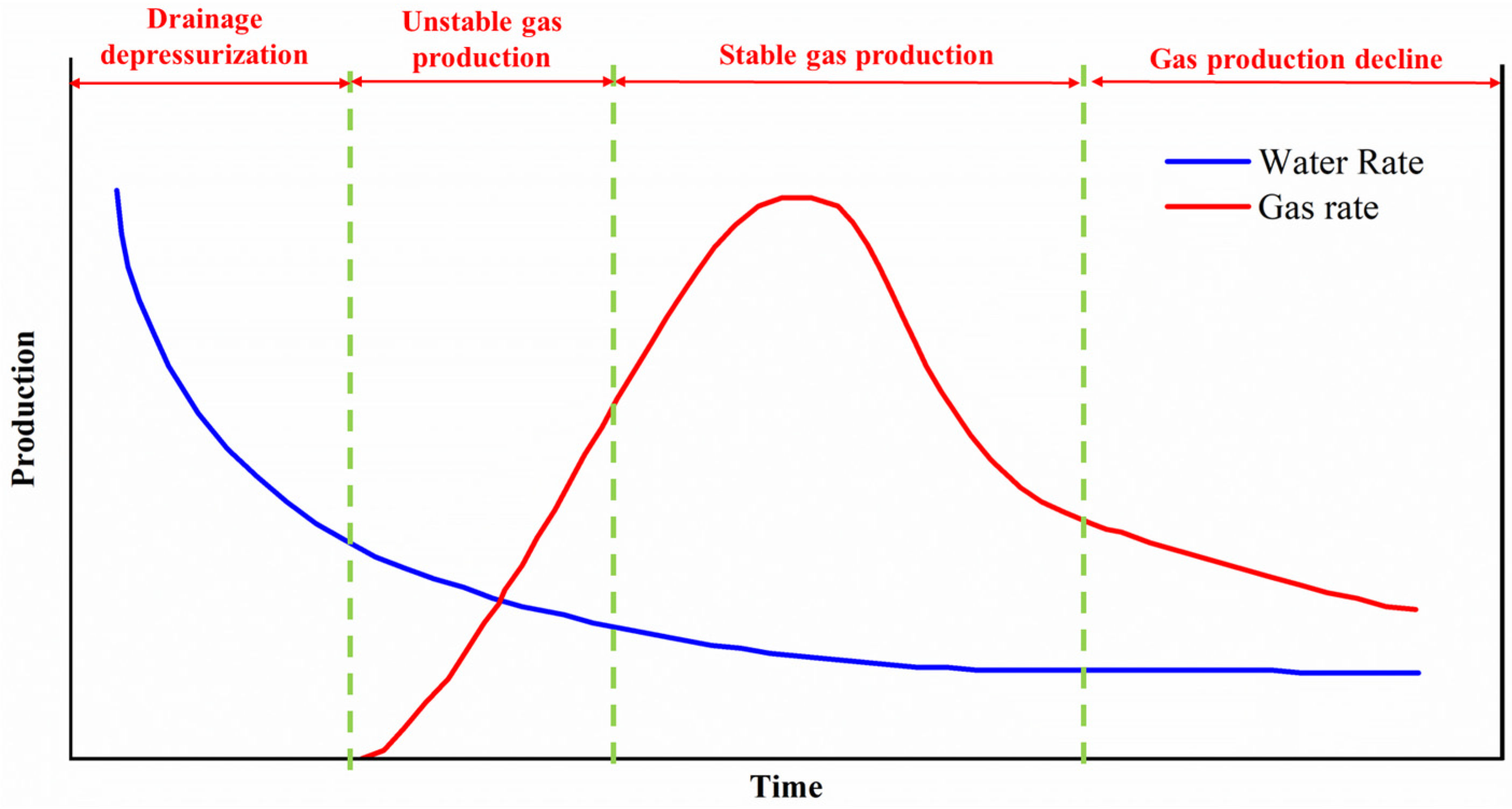
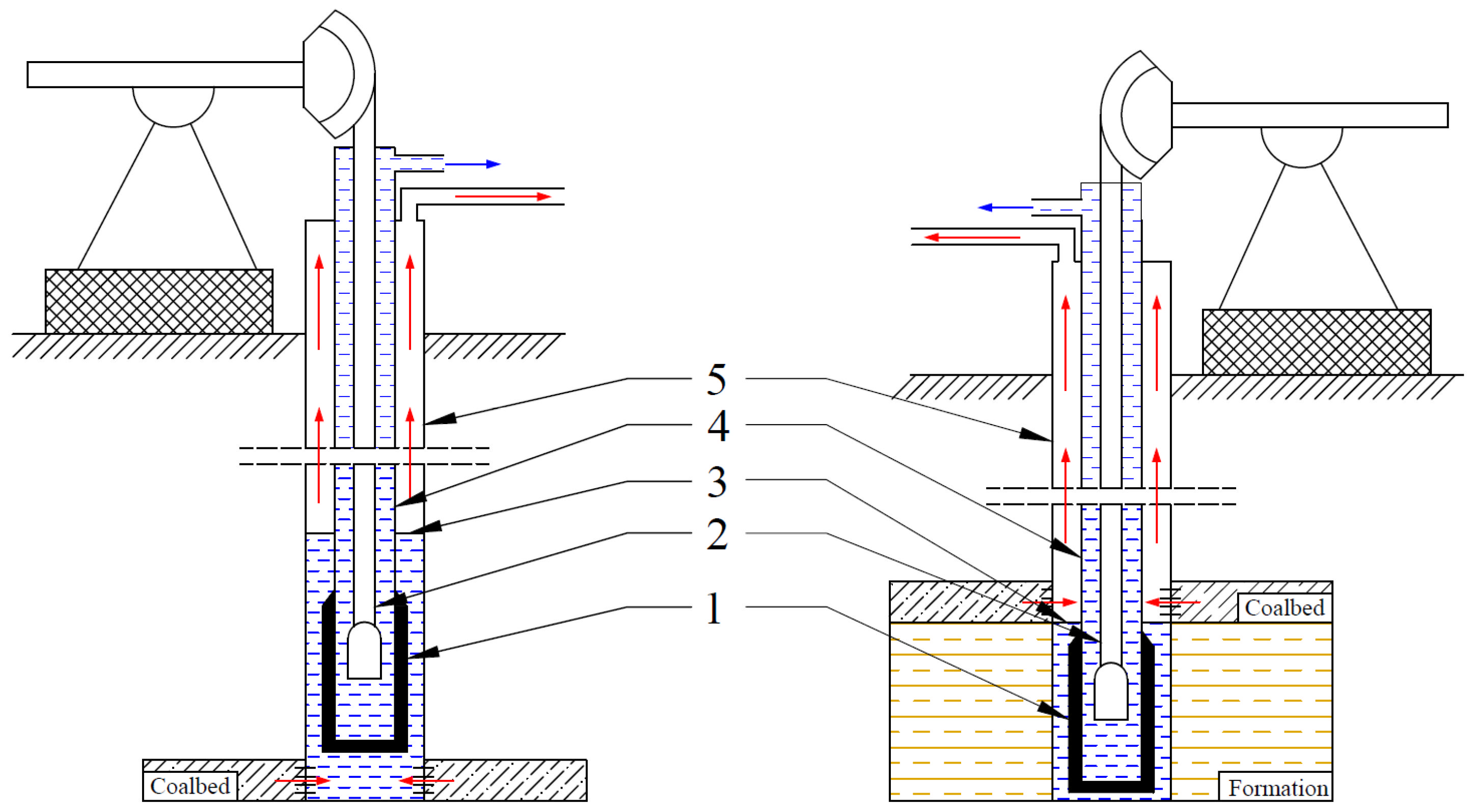
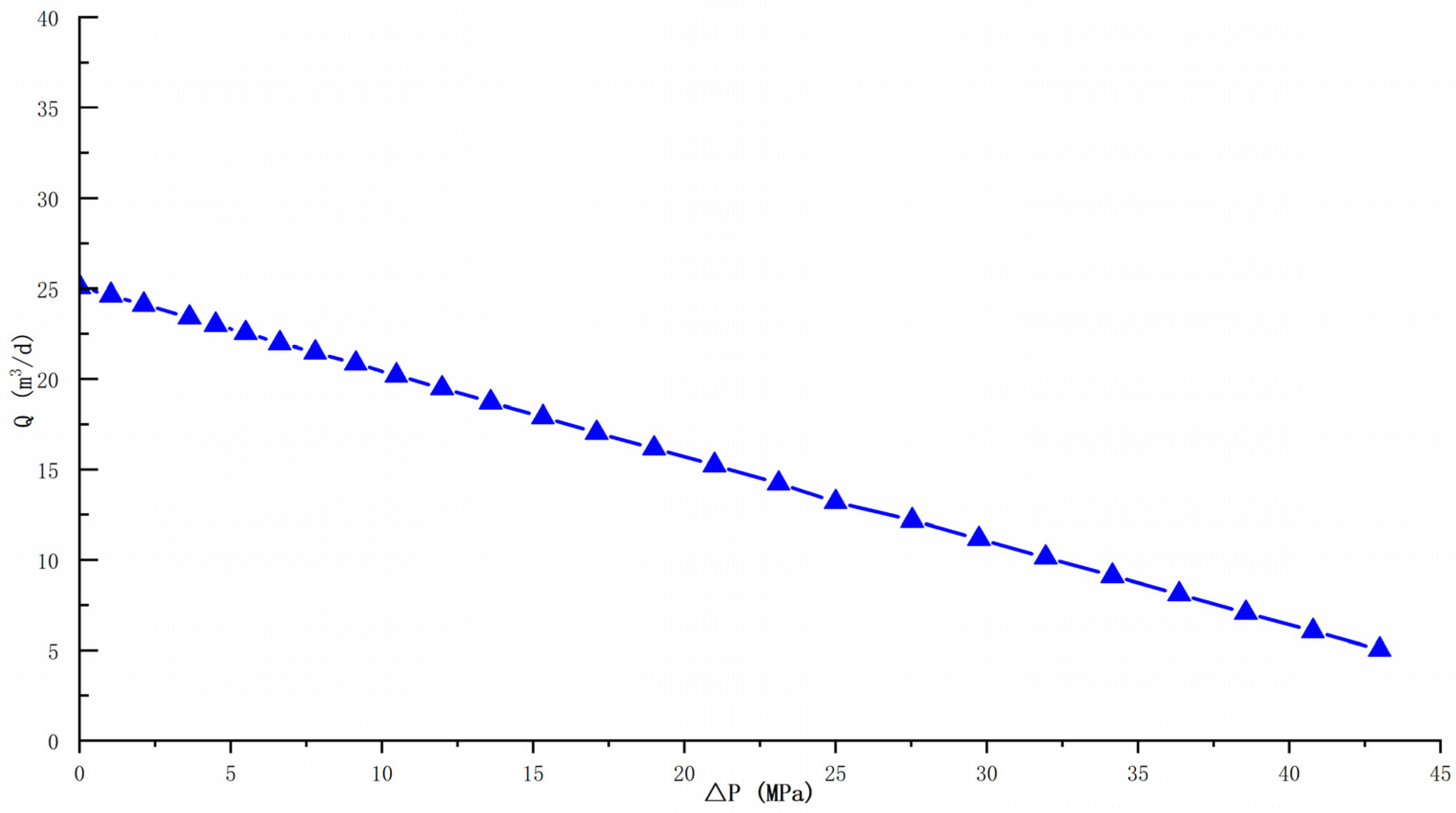
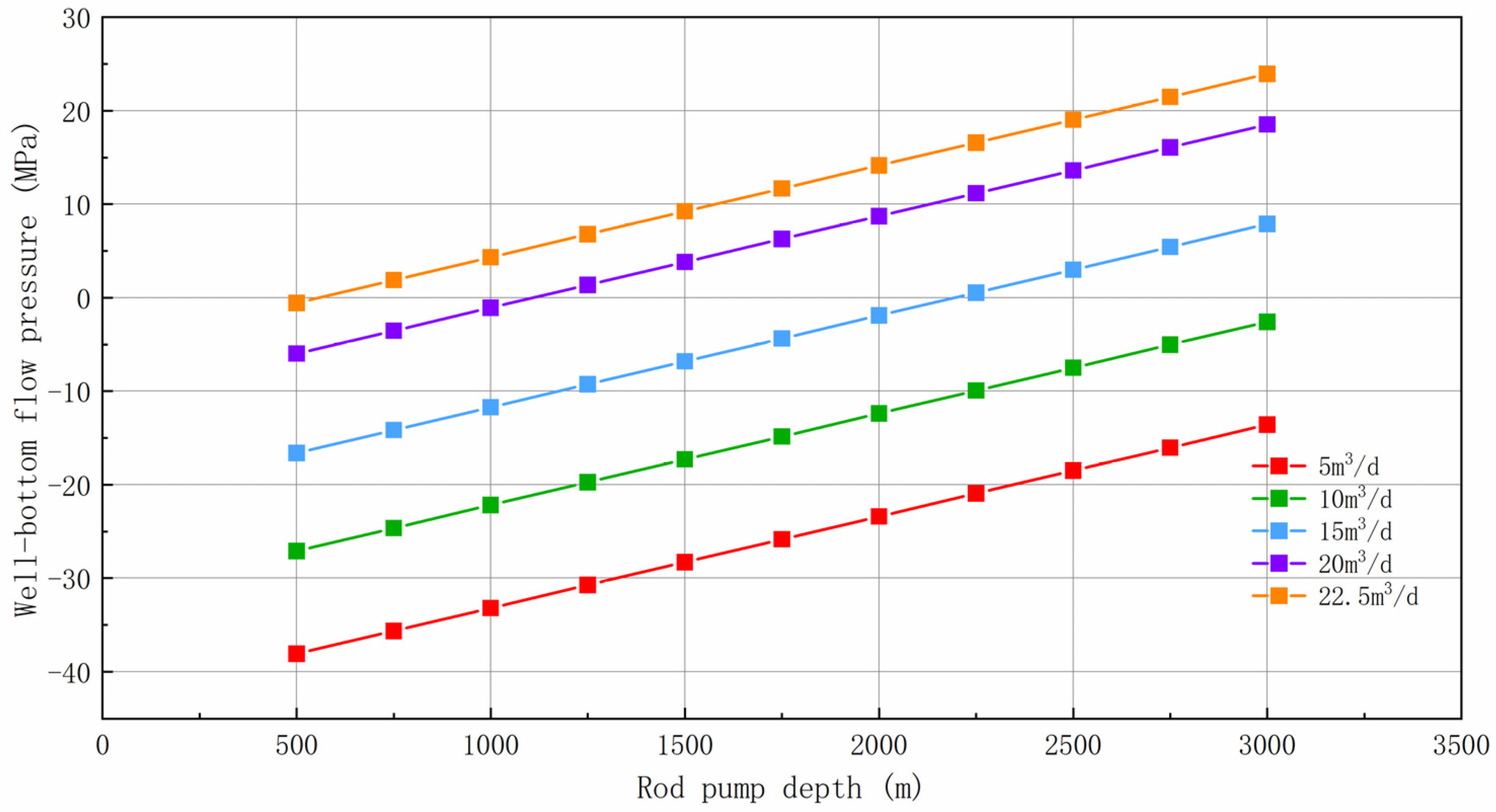


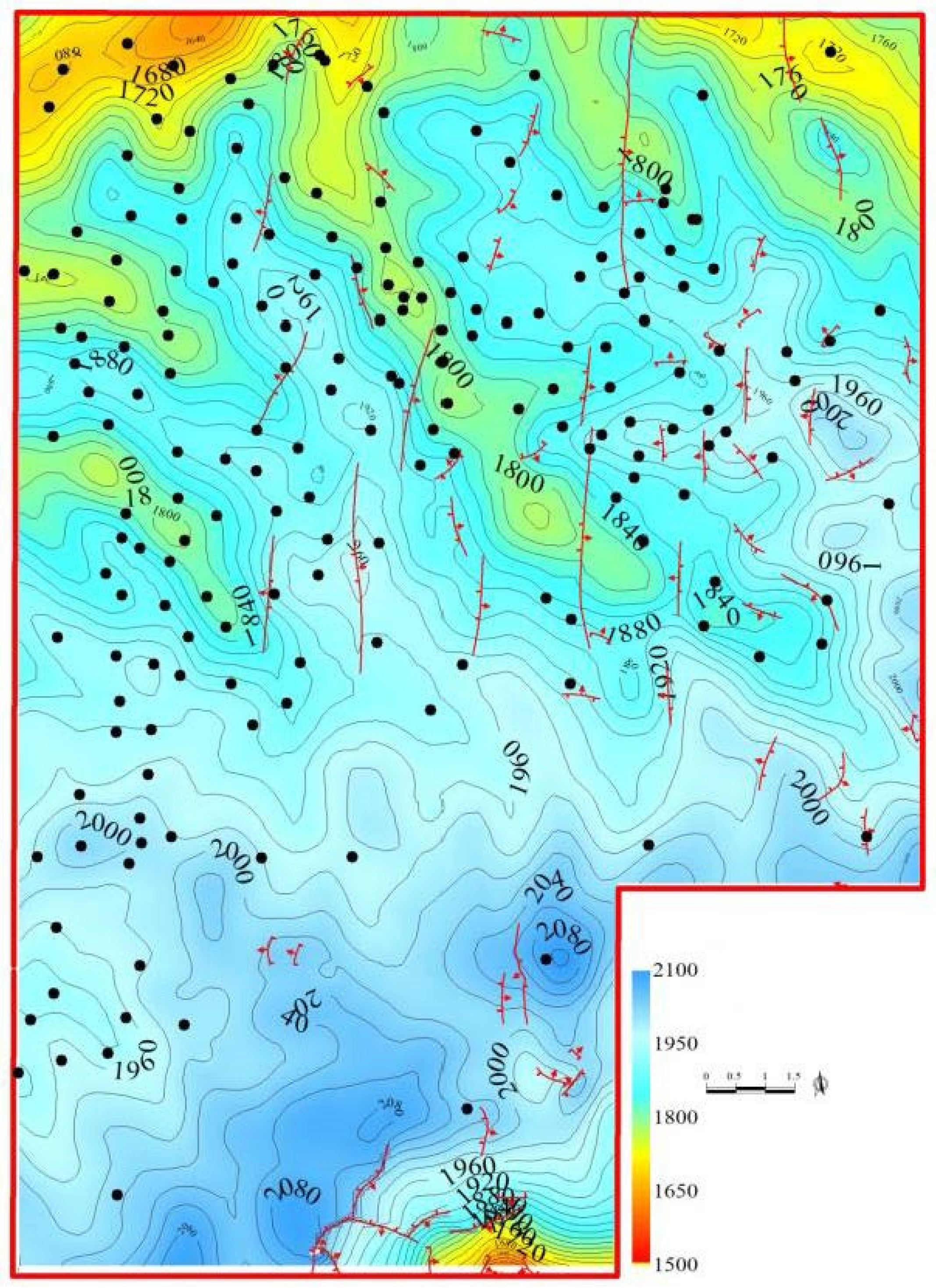
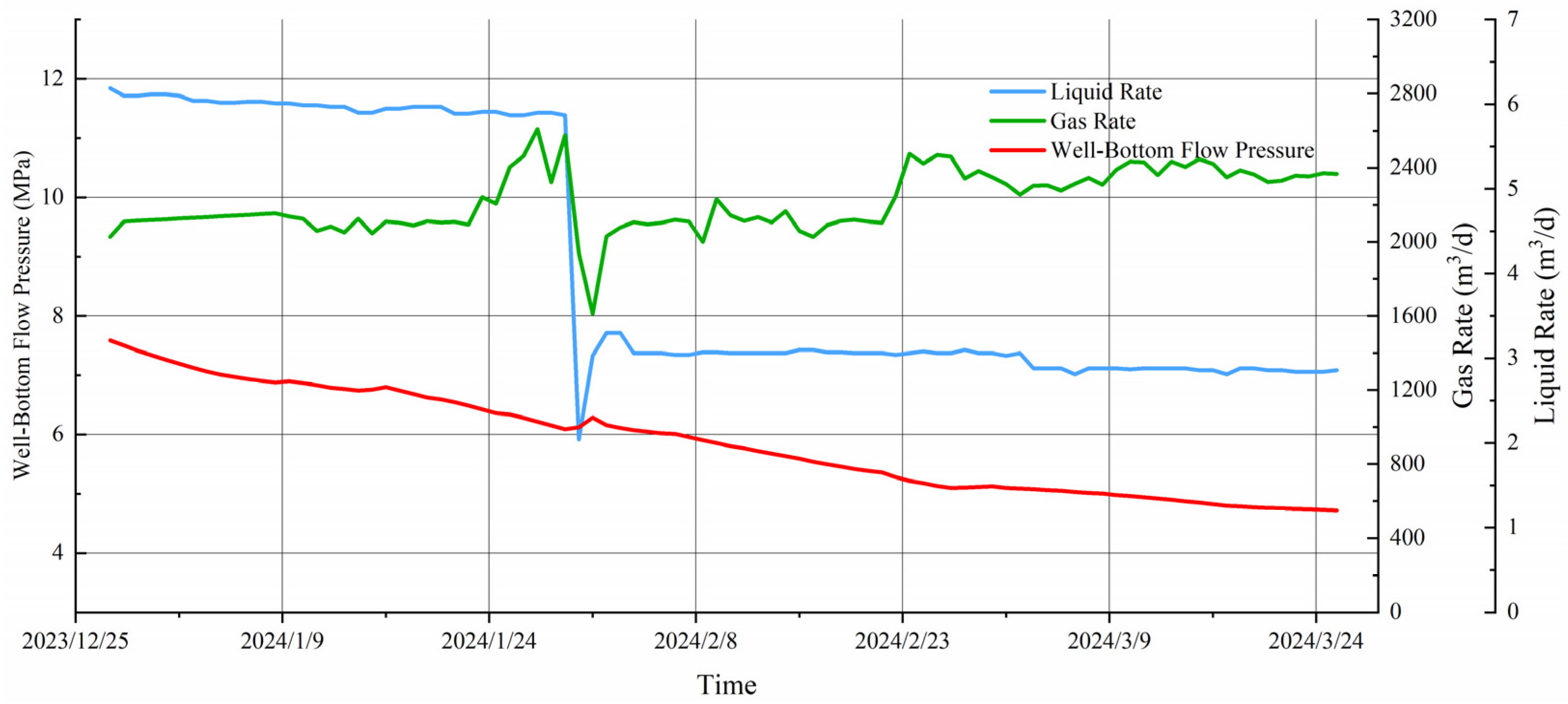


| Stroke Length (m) | Stroke Rate (min−1) |
|---|---|
| 1 | 1.56 |
| 2 | 0.78 |
| 3 | 0.52 |
| 4 | 0.39 |
| 5 | 0.31 |
| 6 | 0.26 |
Disclaimer/Publisher’s Note: The statements, opinions and data contained in all publications are solely those of the individual author(s) and contributor(s) and not of MDPI and/or the editor(s). MDPI and/or the editor(s) disclaim responsibility for any injury to people or property resulting from any ideas, methods, instructions or products referred to in the content. |
© 2024 by the authors. Licensee MDPI, Basel, Switzerland. This article is an open access article distributed under the terms and conditions of the Creative Commons Attribution (CC BY) license (https://creativecommons.org/licenses/by/4.0/).
Share and Cite
Zhang, B.; Jiang, W.; Zhang, H.; An, Y. Optimization Design of Deep-Coalbed Methane Deliquification in the Linxing Block, China. Processes 2024, 12, 1318. https://doi.org/10.3390/pr12071318
Zhang B, Jiang W, Zhang H, An Y. Optimization Design of Deep-Coalbed Methane Deliquification in the Linxing Block, China. Processes. 2024; 12(7):1318. https://doi.org/10.3390/pr12071318
Chicago/Turabian StyleZhang, Bing, Wenbo Jiang, Haifeng Zhang, and Yongsheng An. 2024. "Optimization Design of Deep-Coalbed Methane Deliquification in the Linxing Block, China" Processes 12, no. 7: 1318. https://doi.org/10.3390/pr12071318
APA StyleZhang, B., Jiang, W., Zhang, H., & An, Y. (2024). Optimization Design of Deep-Coalbed Methane Deliquification in the Linxing Block, China. Processes, 12(7), 1318. https://doi.org/10.3390/pr12071318







